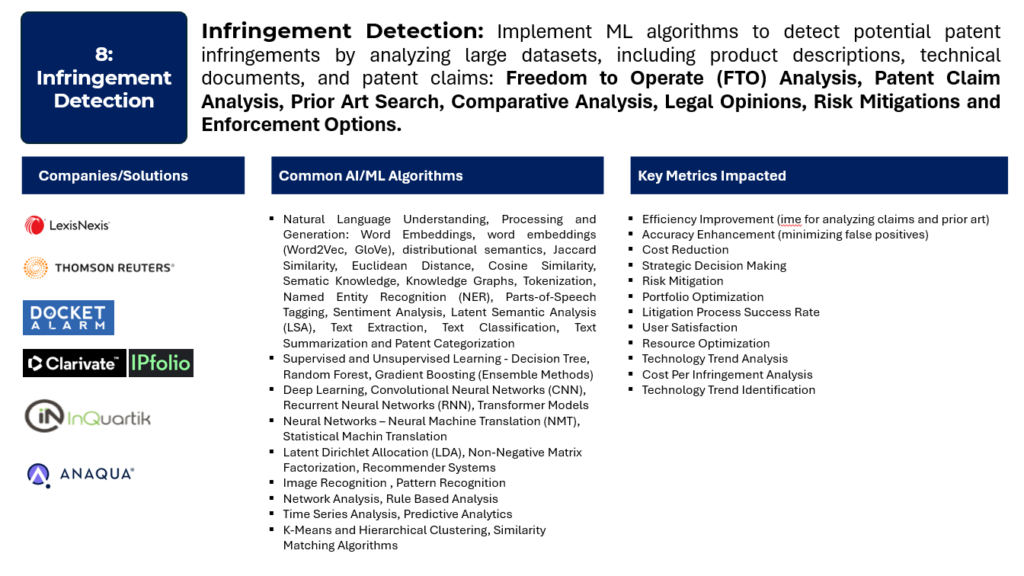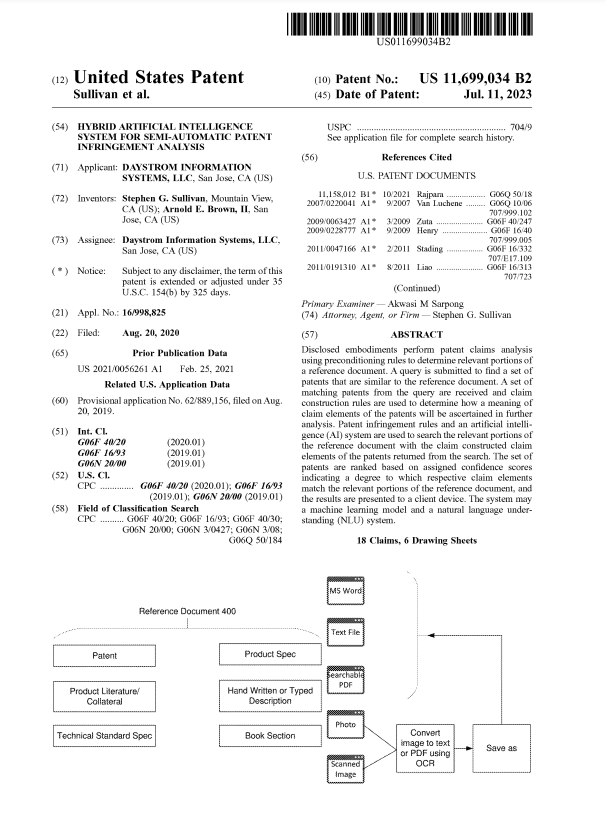Artificial Intelligence (AI) and Machine Learning (ML) can significantly impact patent management by automating and optimizing various tasks. By leveraging AI and ML in these areas, patent management processes can become more efficient, accurate, and proactive, ultimately enhancing the overall effectiveness of intellectual property management strategies. There are several applications and areas where AI/ML can be applied in patent management: Prior Art Search, Automated Patent Drafting, Patent Classification, Patent Valuation, Automated Patent Filing and Prosecution, Patent Portfolio Management, Patent Analytics, Infringement Detection, Technology Landscape Analysis, Patent Litigation Support, Automated Patent Maintenance and Collaborative Innovation Platforms.
H: Infringement Detection
Implement ML algorithms to detect potential patent infringements by analyzing large datasets, including product descriptions, technical documents, and patent claims.
Infringement detection, in the context of patents, refers to the process of identifying instances where a product, technology, or process may be using or implementing patented inventions without proper authorization from the patent holder. Patent infringement occurs when someone else makes, uses, sells, or offers for sale a product or process that falls within the scope of the claims of a valid and enforceable patent. The patent holder has the exclusive right to prevent others from engaging in such activities without their permission. AI/ML is leveraged for infringement detection in the field of intellectual property to identify potential instances of patent infringement. Detection of infringement involves analyzing large datasets of patents and related information to identify whether a product, process, or technology may be infringing on existing patents:
Text and Image Analysis: AI algorithms analyze patent texts, technical documents, and images to identify similarities between existing patents and potentially infringing technologies. Enhances the precision of infringement detection by considering both textual and visual elements. Semantic Analysis: AI employs semantic analysis to understand the context, meaning, and technical details within patent documents and technical literature. Provides a nuanced understanding of patents, enabling more accurate detection of potential infringement. Patent Mapping and Clustering: Machine learning models map and cluster patents based on similarities, helping to identify clusters that may indicate potential infringement. Enables efficient analysis of large patent datasets and identification of technology clusters for focused infringement analysis. Litigation Prediction: Predictive analytics powered by AI assess the likelihood of patents being involved in litigation, helping to identify potential infringement cases. In some cases, companies seek legal opinions from patent attorneys or legal experts specializing in intellectual property law. These opinions assess the likelihood of infringement based on a comprehensive analysis of the patent claims, prior art, and the specific circumstances. Based on the infringement detection results, companies may implement risk mitigation strategies. This could involve redesigning a product to avoid infringement, negotiating licensing agreements with the patent holder, or seeking legal advice on potential defenses.
Portfolio Analysis: AI tools analyze both the patent portfolios of potential infringers and patent holders to identify potential conflicts and instances of infringement. Provides a comprehensive view of the intellectual property landscape, aiding in infringement detection. Key aspects of infringement detection include: Freedom to Operate (FTO) Analysis: Companies conduct FTO analysis to assess whether their planned activities, such as the development, manufacture, or sale of a new product or process, may infringe upon existing patents. FTO analysis aims to identify and mitigate the risk of patent infringement before launching a new product or entering a new market. Patent Claims Analysis: The first step in infringement detection involves a careful analysis of the patent claims. The claims define the scope of the patent, outlining the specific elements or steps that are protected. Comparing the claims to the product or process in question helps determine whether there is a potential overlap. Prior Art Search: Conducting a thorough search for prior art, which includes existing patents, patent applications, and other technical literature, is crucial. The goal is to find relevant documents that may impact the validity or enforceability of the patent in question.
Comparative Analysis: Comparing the features and functionalities of the product or process in question against the elements specified in the patent claims is a critical step. If there is a substantial similarity, there may be a risk of infringement. Enforcement Actions: If infringement is identified and the patent holder decides to take action, they may choose to enforce their rights through legal means. This could involve sending cease-and-desist letters, initiating legal proceedings, and seeking remedies such as injunctions or damages.
AI/ML improves the accuracy and efficiency of infringement detection by automating the analysis of large patent datasets. Predictive analytics powered by AI enable organizations to proactively manage the risk of potential infringement and make informed legal decisions. AI tools help in focusing the analysis on high-risk areas by identifying technology clusters and patterns indicative of potential infringement. By automating the infringement detection process, AI/ML technologies can lead to cost savings by reducing the time and resources required for manual analysis. AI-driven insights assist legal teams in developing effective legal strategies based on the likelihood of litigation and the strength of patents. AI/ML technologies play a crucial role in infringement detection by providing accurate, efficient, and proactive analysis of patent datasets.
Companies that provide legal technology solutions, particularly in the realm of intellectual property, may integrate AI/ML technologies into their platforms to assist in patent infringement detection. These solutions often combine advanced algorithms, natural language processing (NLP), and machine learning to analyze patent claims, compare them with existing products or technologies, and identify potential instances of infringement : LexisNexis IP: LexisNexis provides legal research and information services, and their IP solutions may include features related to patent analysis and infringement. Thomson Reuters: Thomson Reuters offers legal research and intelligence solutions, including those related to intellectual property. AI/ML may be integrated into their platforms for patent-related analysis. Docket Alarm: Docket Alarm provides legal research and analytics services, including tools for tracking and analyzing patent litigation. They may leverage AI for infringement analysis. IPfolio: IPfolio is an Intellectual Property Management platform that may incorporate AI/ML features for patent analytics, potentially including infringement analysis. InQuartik Corporation (Patentcloud): InQuartik offers IP intelligence solutions, and their Patentcloud platform may utilize AI for various patent-related analyses, potentially including infringement detection. Anaqua: Anaqua provides Intellectual Property Management software, and their platform may include features related to patent analysis and portfolio management that leverage AI/ML.

Patent infringement detection involves sophisticated analysis of patent claims, prior art, and the products or processes in question. While specific details about proprietary algorithms used by companies may not be publicly disclosed, the field generally leverages various AI/ML techniques to enhance the accuracy and efficiency of infringement detection: Natural Language Processing (NLP): Analyzing and understanding natural language text in patent claims and legal documents. Extracting key terms, concepts, and relationships from patent texts to facilitate comparison and analysis. Machine Learning for Text Classification: Automatically categorizing and classifying patent documents based on their content. Assigning patents to specific categories, identifying relevant prior art, and assessing the similarity between patent claims and products. Pattern Recognition: Identifying patterns or similarities between patent claims and the features of products or processes. Recognizing recurring elements in patent claims that may indicate potential infringement. Similarity Matching Algorithms: Measuring the similarity between patent claims and the features of products or processes. Comparing textual or structural similarities to identify potential matches or overlaps.
Clustering Algorithms: Grouping patents based on common features or themes. Organizing patents to identify clusters of related inventions and facilitating efficient comparison. Predictive Analytics: Forecasting the likelihood of infringement based on historical data and patterns. Predicting potential areas of risk for infringement and prioritizing analysis efforts. Rule-Based Systems: Applying predefined rules or logic to assess whether specific conditions indicative of infringement are met. Defining rule sets based on legal and technical criteria for automated analysis. Supervised Machine Learning: Training algorithms using labeled datasets to predict whether a given product or process infringes on a patent. Creating models that learn from historical data and are capable of making infringement predictions on new cases. Unsupervised Machine Learning: Purpose: Discovering patterns and relationships in patent data without labeled training examples. Identifying hidden structures or clusters in patent portfolios that may indicate potential infringement issues. Semantic Analysis: Understanding the meaning and context of patent claims and technical descriptions. Enhancing the precision of comparisons by considering the semantic nuances of patent language.
Automating patent infringement detection using AI/ML can impact various metrics and key performance indicators (KPIs) across different stages of the intellectual property management process. By measuring these metrics, organizations can assess the impact and effectiveness of AI/ML-based patent infringement detection systems, make informed improvements, and continually enhance their capabilities in managing intellectual property risks: Efficiency Metrics: Time Saved in Analysis. Reduction in the time taken to analyze patent claims, prior art, and products or processes for potential infringement. Improved efficiency in assessing infringement risks and faster decision-making. Accuracy Metrics: Precision and Recall. Measurement of the precision (accuracy of positive predictions) and recall (sensitivity) of the infringement detection system. Improved accuracy in identifying true instances of infringement while minimizing false positives and false negatives. Risk Mitigation Metrics: Risk Reduction. Quantification of the reduction in the overall risk of unintentional patent infringement. Enhanced risk management and minimized exposure to legal disputes. Cost Reduction Metrics: egal Expenses. Reduction in legal expenses associated with manual infringement analysis and potential litigation. Lower overall costs related to managing and defending against infringement claims.
Operational Metrics: Cases Analyzed per Unit of Time. Increase in the number of patent infringement cases that can be analyzed within a given timeframe. Improved operational scalability and capacity to handle a larger volume of cases. Strategic Decision-Making Metrics: Number of Informed Decisions. Measurement of the increase in the number of informed decisions based on automated infringement analysis. Enhanced strategic decision-making regarding product development, market entry, and patent portfolio management. Portfolio Optimization Metrics: Identification of Redundant Patents. Quantification of the number of redundant patents identified through automated infringement analysis. Streamlined patent portfolios with a focus on valuable and non-redundant assets. Legal Process Metrics: Litigation Success Rate Measurement of the success rate in litigation cases where infringement has been detected. Improved outcomes in legal proceedings and increased chances of successful resolution.
Resource Utilization Metrics: Human Resources Allocation. Assessment of the optimized allocation of human resources for more strategic and complex tasks, with routine tasks automated. Efficient use of human expertise for tasks that require critical analysis and decision-making. Technology Trend Metrics: Identification of Emerging Technologies. Measurement of the system’s capability to identify emerging technologies that may pose infringement risks. Proactive adaptation to changing technology trends and prevention of unintentional infringement. User Satisfaction Metrics: User Feedback and Satisfaction. Collection of feedback from users, stakeholders, and legal teams regarding the effectiveness and usability of the automated system. Enhanced user satisfaction and engagement with the infringement detection process. Cost per Infringement Analysis: Cost associated with analyzing each patent for potential infringement. Improved cost-effectiveness in the infringement detection process.
H: Example

Hybrid artificial intelligence system for semi-automatic patent infringement analysis
Assignee Daystrom Information Systems LLC
The disclosed embodiments involve a method for analyzing patent claims using preconditioning rules to identify relevant portions of a reference document :
Query Submission and Matching: A query is submitted to identify a set of patents that share similarities with the reference document.
Claim Construction Rules: Claim construction rules are applied to determine the meaning of claim elements in the identified patents. This step sets the foundation for further analysis.
Search with AI System: Patent infringement rules and an artificial intelligence (AI) system are employed to search the relevant portions of the reference document. The search is conducted using the claim-constructed elements obtained from the identified patents.
Ranking and Confidence Scores: The set of patents is ranked based on confidence scores, indicating the degree to which the claim elements align with the relevant portions of the reference document.
Presentation of Results: The results, including the ranked set of patents and associated confidence scores, are presented to a client device.
Additionally, the system may incorporate a machine learning model and a natural language understanding (NLU) system to enhance the analysis process. Overall, the disclosed method integrates various rules and technologies to efficiently analyze patent claims, assess relevance, and present results to users.
References
Infringement Detection:
Book: “Patent Infringement: Compensation and Damages” by Roland K. Wall
Article: “Patent Infringement Detection Using Machine Learning” by Bhagyashri Tushar Patil and M. S. Santhosh (International Journal of Computer Applications, 2019)
Webinar: “AI in Intellectual Property: Infringement Detection” by IPWatchdog
Course: “Patent Infringement: A Comprehensive Guide” on Udemy
Blog Post: “Using AI for Patent Infringement Analysis” by Cipher




